Armand Rousso, entrepreneur, philanthropist,
chess aficionado
By Frederic Friedel
 I
got to know Armand Rousso on January 5th, 2003 – on the telephone. The
founder of a company manufacturing 3D
shutter glasses and computer monitors had just agreed to stage a man vs
machine match between Garry Kasparov and Deep Junior. It was a match which
FIDE president Kirsan Ilyumzhinov had announced but was unable to actually
stage. Rousso, with his company X3D Technologies, had agreed to take over and
do it in the classy New York Athletic Club.
I
got to know Armand Rousso on January 5th, 2003 – on the telephone. The
founder of a company manufacturing 3D
shutter glasses and computer monitors had just agreed to stage a man vs
machine match between Garry Kasparov and Deep Junior. It was a match which
FIDE president Kirsan Ilyumzhinov had announced but was unable to actually
stage. Rousso, with his company X3D Technologies, had agreed to take over and
do it in the classy New York Athletic Club.
Rousso and X3D Technologies had already proved their mettle in chess events.
Just a few weeks earlier they had organised a rapid chess match between Garry
Kasparov and Anatoly Karpov, right on Times Square in the heart of New York
City.
For the match Kasparov
vs Deep Junior Rousso expected a gigantic audience: over a million people
watching live online, he told me. Could we provide the facilities for the Internet
coverage? Indeed we could, ChessBase had developed a cascading Flash technology
for the match Kramnik
vs Deep Fritz in Bahrain the year before.

Kasparov vs Deep Junior on the giant 3D projection screen
Three weeks later I was in New York to set up live Internet broadcast for
giant international news portals which Rousso had won as partners: AOL, Wired,
Der Spiegel, T-Online, Le Figaro, Chathurangam, etc. A number of million people
tuned in, hundreds
of articles were published, and ESPN even transmitted part of the final
game live to their audience.

During this event I met Armand Rousso, a hefty French-born entrepreneur, mid
fifty, brimming with energy and enthusiasm. During his 25-year career he has
created over thirty companies and filed over 100 patents worldwide.
Most impressively Armand was one of the first people to truly grasp the power
of the Internet, as I found out in our extended dinner conversations. That
was back in the mid 1980’s, when the Internet was still referred to as
a "bulletin board" and mainly used by university techies and the
US military.
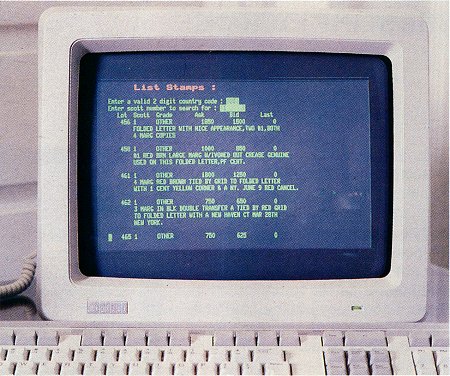
The original real-time e-commerce application, set up by Rousso in 1985
Armand started an e-commerce company, the first on the net, that was just
one step away from Ebay and all of today's online marketplaces. The mind boggles
when one considers what might have happened if he had filed patents at the
time! At the bottom of this page you will find articles
on his International Stamp Exchange.

Garry Kasparov testing the X3D chess display in July 2003
Already in January 2003 Armand was planning the next big event. In July I
travelled to New York again to spend a week with him designing that event.
We came up with a virtual
reality 3D board on which Kasparov would play, wearing X3D shutter glasses
that made the chess set appear to float out of the monitor.
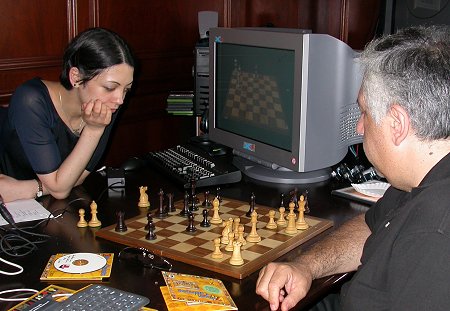
Armand Rousso taking on U.S. Women's Champion Anna Hahn in a blitz game.
Armand is a 2200+ player who recently won a regular game against GM Ron Henley.
During this visit Armand invited me to stay in his Manhattan apartment, so
we could spend the evenings discussing the details of the match and the technology
that was needed. That was a good idea, except that his residence was a tiny
bit distracting...

The view from my bedroom, which directly overlooked Ground Zero

Sunset over the Hudson, as seen from Armand's living room window front
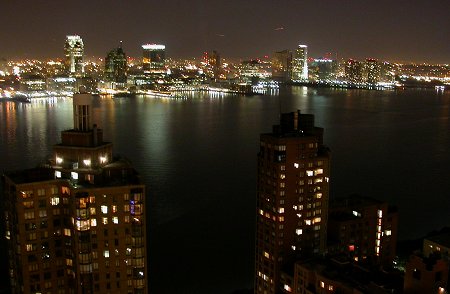
Manhattan and New Jersey by night – how can anyone talk business
and technology when there is such a breathtaking view all around you?
The match between Kasparov
and X3D Fritz was an unprecedented success, generating more media coverage
than any chess game in history. At one stage there were 46,000 articles listed
in Google, the event was carried live on the Internet (through AOL and the
other portals) to literally millions of viewers, and it was shown in 17½
hours of live broadcast on America's biggest cable TV sports channel, ESPN.

During that match I learnt a lot about the art of presentation in chess. Why,
for instance, did the newspapers print so many articles on Kasparov vs X3D
Fritz? Certainly the name was important: if Kasparov plays a fox terrier in
New York, that is going to make the news. Of course the battle of man vs his
nemesis, the machine, fires the imagination of many. But 46,000 articles?
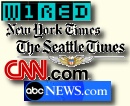 The
trick was of course the glasses, which Armand had talked Garry into accepting.
You can imagine the conversation that took place in thousands of newspaper
offices all over the world. Editor, looking at a picture: "Why is he wearing
dark glasses?" Staff writer: "They are 3D glasses, and he's playing
in a virtual reality environment." Editor: "No chess board?"
Staff writer: "No, just a 3D image which is floating in front of the screen."
Editor: "A hologram! Cool! Do we have copy?" Staff writer: "Plenty,
they sent stories, analysis,..." Editor: "Pictures?" Staff writer:
"Lots and lots. By the way even ESPN..." Editor: "Great, we
put it in full size on page six, with a teaser on page one. Tell me how it
ends. Hope the Kasparov guy wins. That would be so cool."
The
trick was of course the glasses, which Armand had talked Garry into accepting.
You can imagine the conversation that took place in thousands of newspaper
offices all over the world. Editor, looking at a picture: "Why is he wearing
dark glasses?" Staff writer: "They are 3D glasses, and he's playing
in a virtual reality environment." Editor: "No chess board?"
Staff writer: "No, just a 3D image which is floating in front of the screen."
Editor: "A hologram! Cool! Do we have copy?" Staff writer: "Plenty,
they sent stories, analysis,..." Editor: "Pictures?" Staff writer:
"Lots and lots. By the way even ESPN..." Editor: "Great, we
put it in full size on page six, with a teaser on page one. Tell me how it
ends. Hope the Kasparov guy wins. That would be so cool."
Links
Armand's scrapbook
There is a lot more to tell about Armand Rousso – and it will be all
told in time. For instance that he is a very proficient contact magician. Which
is why colleague David Blaine is likely to turn up during his events.
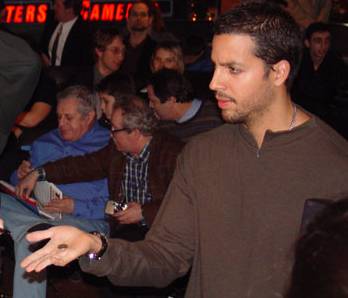
Magician David Blaine at the Kasparov-Karpov match
Armand is also generous to a fault. He is constantly supporting worthy and
unworthy causes, donating large sums to charities, sometimes to the chagrin
of his company. I have seen him impulsively shell out $2,000 in cash (without
any receipt) to a woman grandmaster when he learnt that she did not have a
proper computer.

Armand has donated heavily to the USCF and other chess organisations, and
to the New York City Sports Development Commission, chaired by his friend Michael
R. Bloomberg, who has cited him for his numerous charitable efforts benefiting
the children and the underprivileged of the City.
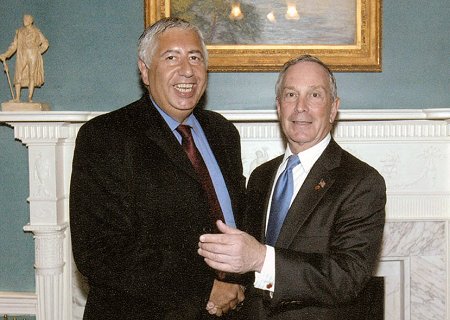
Buddies: Armand Rousso with Mayor Bloomberg of New York City
In lengthy negotiations I was able to get permission to scan some of the pictures
that adorn Armand's apartment and office. Here is a selection of those photos.

Early picture of Armand with Ronald Reagan, whom he frequently met

President Ronald Reagan being presented with the Freedom Stamps by Armand
Rousso at the 1988 Senatorial Inner Circle Spring Dinner in Washington, DC.

Reagan's letter of thanks to Armand Rousso

President Bill Clinton with Armand Rousso at Clinton’s 50th birthday
party in New York City, 1996

With world welterweight champion and Olympic boxing Gold Medalist Oscar
de la Hoya in 1997

Garry Kasparov and Armand Rousso during the first man vs machine in 2003

Armand with Anatoly Karpov, a fellow philatelist, in New York 2002
From the dawn of the Internet

THE WEEKLY NEWS MAGAZINE
TIME, October 7, 1985
Trading Stamps by Computer
 Most
people use stamps to mail letters. Rousso trades them for expensive houses,
yachts and cars. A Miami Beach philatelic broker, Rousso, 35, says that official
catalogs value the rare stamps that he has traded since 1984 at $45 million.
Now he is taking the art of stamp trading into the computer age. Starting this
week, collectors worldwide will be able to buy and sell rare stamps via telex
through Rousso's Miami-based International Stamp Exchange Corp. In
a month, stamp buffs will also be able to trade through personal computers.
Most
people use stamps to mail letters. Rousso trades them for expensive houses,
yachts and cars. A Miami Beach philatelic broker, Rousso, 35, says that official
catalogs value the rare stamps that he has traded since 1984 at $45 million.
Now he is taking the art of stamp trading into the computer age. Starting this
week, collectors worldwide will be able to buy and sell rare stamps via telex
through Rousso's Miami-based International Stamp Exchange Corp. In
a month, stamp buffs will also be able to trade through personal computers.
Rousso expects some 300,000 U.S. collectors and thousands more abroad to use
ISEC, for which they will pay 3% buyer’s fees and 6% selling commissions.
By making trading convenient, he also expects to attract new collectors. To
ensure the authenticity and quality of stamps listed on the exchange, ISEC’s
staff experts will take possession and verify descriptions before posting sell
orders. The price a buyer will pay for a stamp, of course, depends on numerous
factors. The famous “Inverted Jenny” from the first U.S. airmail
issue in 1918 is especially valued by collectors for one striking error: the
airplane is flying upside down.

New York, Friday, January
3, 1986
Frenchman in Florida Creates ‘Big Board’ for Stamp Trading
...Rousso, the owner and chairman of the International Stamp Exchange Corporation
of Miami Beach believes he can revive interest in philately with a combination
of publicity and the lure of profit. “There is not doubt that collecting
stamps is not seen today as a modern, fashionable hobby” he said. “We
are trying to dust it off and show, especially to young people, that it can
be great fun and, what is more important, very profitable.”
In the exchange, which opened in October and which Mr. Rousso expects to
be fully operational later this month, descriptions of each stamp, including
the owner’s asking price, are fed to a computer. Potential buyers, dealers,
or individuals who have telex terminals or personal computers can see the exchange’s
listings of stamps and enter bids on them. If the bid equals the price asked,
the sale is automatically completed by the exchange. If the bid is lower, the
seller can choose to accept it. Buyers are charged 3 percent and sellers are
charged 6 percent. Auction houses usually collect 10 percent from both the
seller and the buyer.
Mr. Rousso said that in a 10-day period from the last of November to the
first week of December, the exchange’s volume of business was $400,000
and increased daily. Mr. Rousso placed a $3 million value on the stamps the
exchange initially offered for sale and said the value of those listed now
was about $75 million. The number of serious American stamp collectors, who
annually invest several hundred dollars in their collections, is estimated
at some 200,000, although the number who dabble in philately could be ten times
that number. His experience as a collector and dealer has led to a network
of 200 authorized representatives in the United States. Through them, people
who do not own computers can buy or sell stamps on the exchange. Mr. Rousso
also has subsidiaries in Austria, Brazil, Canada, France, Britain, Italy, Japan,
Switzerland, and West Germany.

Stamp Traders New Exchange Widens Market
The new office houses a computer containing information on stamps for sale-about
one million at the moment. Traders can gain access to the exchange, and make
trades, through their own personal computers. Or they can trade through brokers
at the exchange or through any of 150 dealers who are exchange members.
 Sellers
set the “ask” prices they want for stamps, which they turn over
to be graded and insured by exchange officials and stored in vaults pending
their sale. Meanwhile, buyers submit “bid” prices, which
are compared with the sellers’ ask prices. If the bid and ask prices
match, a computer automatically records a sale. If the prices are close, the
buyer and seller are invited to negotiate. When sales occur, the exchange typically
collects a commission of 3% from buyers and 6% from sellers. That compares
with a commission of 10% collected from each side at most major stamp auctions.
Sellers
set the “ask” prices they want for stamps, which they turn over
to be graded and insured by exchange officials and stored in vaults pending
their sale. Meanwhile, buyers submit “bid” prices, which
are compared with the sellers’ ask prices. If the bid and ask prices
match, a computer automatically records a sale. If the prices are close, the
buyer and seller are invited to negotiate. When sales occur, the exchange typically
collects a commission of 3% from buyers and 6% from sellers. That compares
with a commission of 10% collected from each side at most major stamp auctions.
One advantage for the collector is access to up-to-date prices. Previously,
if an investor sought to sell stamps, say, six months after a catalog was issued,
the printed price would often be outdated. And unscrupulous dealers could take
advantage of the difference. The exchange also enables investors to quickly
shop around for the best price. At the same time, individual dealers can offer
a wider range of stamps to clients without personally having to store them.
Rousso, the exchange’s chairman, says his computer network will “inject
fresh money into the market that will benefit everybody.” In its first
six months, the exchange handled about $1 million in transactions, Mr. Rousso
says.
Dealers say that’s still only a tiny fraction of philatelic revenue,
which many estimate at $500 million a year. Yet some participating collectors
are enthusiastic. The exchange “has done for stamps what Nasdaq did for
the OTC market in the 1970’s,“ says Moshe Rimson, and avid collector
and the president of M. Rimson & Co., a New York stockbroker. Adds Lewis
Berg, the vice president of Southeastern Stamp Co., a Hollywood, Fla. Auctioneer:
“It should bring the stamp business into the modern era.”

September 9, 1985
On Sept. 30, investors will be able to buy and sell rare stamps that way they
trade securities-by computer. Collectors used to be limited to catalogs, dealers,
and auction houses. But soon they can tap a new electronic market, run by the
International Stamp Exchange Corp. in Miami Beach that will feature up-to-date
prices and bids.
Using the market requires only a computer with a modem and 60 cents a minute
for line charges. Traders will have access to data on more than 800,000 stamps,
plus the services of at least 200 stamp dealers acting as brokers. The brokers
will share a 6% sellers’ fee and a 3% buyer’s fee that the exchange
will charge traders using this service.
Rousso, a leading trader of rare stamps who is chairman, president, and founder
of ISE. Anyone with a computer and a modem can contact ISE, get a password,
and call in. The service will also be available via MCI International Inc.’s
“Insight,” a 24-hour news and information service. The wholesale
and retail market for stamps worldwide adds up to about $470 million each year.
Now Rousso predicts the exchange will enable the rare-stamp market to “at
least double” by 1990.

September 16, 1985
People to Watch
Rousso, 35, has come a long way from his teenage days in Paris when he used
to barter old stamps for meals in a Chinese restaurant. Now based in Palm Beach,
Florida, Rousso in the past 18 months has exchanged millions of dollars worth
of rare stamps for yachts, real estate, and private jets, most of which he
then sold to reinvest in more stamps. Anyone looking to get portable assets
in return for a spare oil well or gold mine will have to wait, though, as Rousso
has suspended dealing to concentrate on his International Stock Exchange, due
to open September 30. Philatelic traders will hook up through the exchange
via computer or telex, paying Rousso a percentage of each transaction’s
value. Rousso acquired the venture’s Miami Beach office space for about
$1.5 million-in stamps. “That’s the fun of it,” he says.


















 I
got to know Armand Rousso on January 5th, 2003 – on the telephone. The
founder of a company manufacturing
I
got to know Armand Rousso on January 5th, 2003 – on the telephone. The
founder of a company manufacturing 









 The
trick was of course the glasses, which Armand had talked Garry into accepting.
You can imagine the conversation that took place in thousands of newspaper
offices all over the world. Editor, looking at a picture: "Why is he wearing
dark glasses?" Staff writer: "They are 3D glasses, and he's playing
in a virtual reality environment." Editor: "No chess board?"
Staff writer: "No, just a 3D image which is floating in front of the screen."
Editor: "A hologram! Cool! Do we have copy?" Staff writer: "Plenty,
they sent stories, analysis,..." Editor: "Pictures?" Staff writer:
"Lots and lots. By the way even ESPN..." Editor: "Great, we
put it in full size on page six, with a teaser on page one. Tell me how it
ends. Hope the Kasparov guy wins. That would be so cool."
The
trick was of course the glasses, which Armand had talked Garry into accepting.
You can imagine the conversation that took place in thousands of newspaper
offices all over the world. Editor, looking at a picture: "Why is he wearing
dark glasses?" Staff writer: "They are 3D glasses, and he's playing
in a virtual reality environment." Editor: "No chess board?"
Staff writer: "No, just a 3D image which is floating in front of the screen."
Editor: "A hologram! Cool! Do we have copy?" Staff writer: "Plenty,
they sent stories, analysis,..." Editor: "Pictures?" Staff writer:
"Lots and lots. By the way even ESPN..." Editor: "Great, we
put it in full size on page six, with a teaser on page one. Tell me how it
ends. Hope the Kasparov guy wins. That would be so cool."










 Most
people use stamps to mail letters. Rousso trades them for expensive houses,
yachts and cars. A Miami Beach philatelic broker, Rousso, 35, says that official
catalogs value the rare stamps that he has traded since 1984 at $45 million.
Now he is taking the art of stamp trading into the computer age. Starting this
week, collectors worldwide will be able to buy and sell rare stamps via telex
through Rousso's Miami-based International Stamp Exchange Corp. In
a month, stamp buffs will also be able to trade through personal computers.
Most
people use stamps to mail letters. Rousso trades them for expensive houses,
yachts and cars. A Miami Beach philatelic broker, Rousso, 35, says that official
catalogs value the rare stamps that he has traded since 1984 at $45 million.
Now he is taking the art of stamp trading into the computer age. Starting this
week, collectors worldwide will be able to buy and sell rare stamps via telex
through Rousso's Miami-based International Stamp Exchange Corp. In
a month, stamp buffs will also be able to trade through personal computers.


 Sellers
set the “ask” prices they want for stamps, which they turn over
to be graded and insured by exchange officials and stored in vaults pending
their sale. Meanwhile, buyers submit “bid” prices, which
are compared with the sellers’ ask prices. If the bid and ask prices
match, a computer automatically records a sale. If the prices are close, the
buyer and seller are invited to negotiate. When sales occur, the exchange typically
collects a commission of 3% from buyers and 6% from sellers. That compares
with a commission of 10% collected from each side at most major stamp auctions.
Sellers
set the “ask” prices they want for stamps, which they turn over
to be graded and insured by exchange officials and stored in vaults pending
their sale. Meanwhile, buyers submit “bid” prices, which
are compared with the sellers’ ask prices. If the bid and ask prices
match, a computer automatically records a sale. If the prices are close, the
buyer and seller are invited to negotiate. When sales occur, the exchange typically
collects a commission of 3% from buyers and 6% from sellers. That compares
with a commission of 10% collected from each side at most major stamp auctions.






